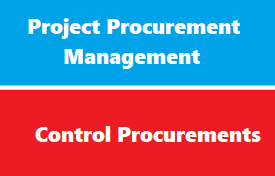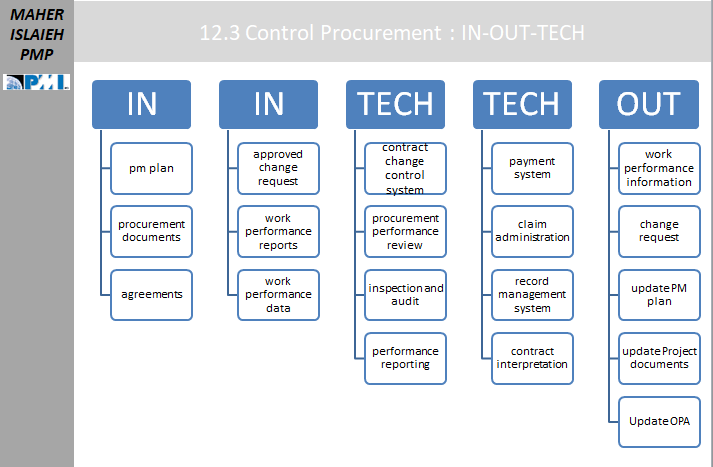introduction
Control Procurements is the process of managing procurement relationships, monitoring contract performance, and making changes and corrections to contracts as appropriate.
The key benefit of this process is that it ensures that both the seller’s and buyer’s performance meets procurement requirements according to the terms of the legal agreement
Concepts
Concepts
Control Procurement :
- Manage procurements relationships, monitor contract performance and make changes and corrections as needed
Payment System:
- Handled by the accounts payable department. Must include reviews and approvals of seller invoices by the project team prior to issuing a payment to a seller.
Inspections and Audits;
- required by the buyer and supported by the seller to identify any weaknesses in the seller’s work performance or deliverables
Claims Administration:
- (disputes or appeals)
- Where buyer and seller cannot agree on compensation for the change, or that a change has even occurred. Should be documented and managed in accordance with the terms of the contract .Might involve arbitration or litigation
Record Management System:
- A set of processes and automation tools consolidated into the project Management Information System to manage contract documentation and records.
- To maintain an index of contract records, and correspondences for archiving and future use
Work Performance Information
Work Performance Information, Includes the following :
- The extent to which quality standards are being met.
- indicates which deliverables have been completed.
- Identifies which costs have been incurred.
- Seller invoices: submitted from time to time to request payment for work performed
Contract Change Control System
Contract Change Control System
- Defines the process by which the contract may be modified.
- It includes the paperwork, tracking systems, dispute resolution procedures, and approval levels necessary for authorizing changes.
- Should be integrated with the integrated change control system Seller invoices: submitted
process inputs - techniques - outputs
Inputs
- pm plan
- procurement documents
- agreements
- approved change request
- work performance reports
- work performance data
Techniques
- contract change control system
- procurement performance review
- inspection and audit
- performance reporting
- payment system
- claim administration
- record management system
- contract interpretation
Outputs
- work performance information
- change request
- update PM plan
- update Project documents
- Update OPA
Control Procurement: Inputs
Control Procurement: Inputs
Project Management Plan
But other components of the overall project management plan may also be inputs as well, such as:
- Requirements management plan–describes how the contractor requirements will be analyzed, documented, and managed
- Risk management plan–describes how risk activities created by the sellers will be structured and performed for the project
- Change management plan–contains information about how seller-created changes will be processed.
- Schedule baseline–if there are slippages created by sellers that impact the overall project performance, the schedule may need to be updated and approved
Project Documents
The project documents that can be considered as inputs to this process include:
- Assumption log–assumptions that have been made during the procurement process will be added to this log
- Lessons learned register–as with many other processes, lessons learned earlier in the project can be applied further along in the project, in this case, to improve contractor performance and the procurement process.
- Milestone list–shows when the sellers are expected to deliver their results
- Quality reports–identifies seller processes, procedures, or products that are out of compliance.
- Requirements documentation–may include”
- Technical requirements the seller is required to satisfy
- Requirements with contractual and legal implications
- Requirements traceability matrix–links product requirements from their origin to the deliverables that satisfy them, and shows the owner of requirements who should be consulted and/or informed about any issues related to those requirements
- Risk register–risk related to the approved sellers are added to the register, including those related to:
- The seller’s organization
- The duration of the contract
- The external environment
- The project delivery method
- Type of contracting vehicle chosen (fixed-cost or cost-reimbursable)
- Final agreed-upon price
- Stakeholder register–includes information about identified stakeholders, in particular contracted team members, selected sellers, contracting officers, and other stakeholders who are involved in procurements.
Agreements
The following documents related to procurements may be used in this process.
- Procurement state of work (SOW)
- Payment information
- Contractor work performance information
- Plans, drawings
- Correspondence
Approved Change Requests
may include:
- Terms and conditions of the contract
- Procurement statement of work (SOW)
- Pricing
- Descriptions of the products, services, or results to be provided.
Work Performance Data
Seller data on project status may include:
- Technical performance
- Activities that have been started, are in progress, or have been completed
- Costs incurred or committed
- Seller invoices that have been paid
Enterprise Environmental Factors
EEF include:
- Contract change control system
- Marketplace conditions
- Financial management and accounts payable system
Organizational Process Assets
- The organizational process asset (under the organization’s control) that can influence this process includes procurement policies of the organization
Control Procurements: Tools and Techniques
Control Procurements: Tools and Techniques
Expert Judgment
Include :
- Expertise should be considered from individuals or groups with specialized knowledge related to procurements. In particular, those with expertise in
- Relevant functional areas including supply chain management
- Laws, regulations, and compliance requirements,
- Claims administration (in case of a disputed agreement with a seller)
Claims Administration
- If there are contested changes to the agreement where the buyer and seller cannot reach an agreement, then the contested change becomes a claim, and needs to be resolved.
- It may be handled through alternative dispute resolution (ADR) following procedures established in the agreement. If it cannot be resolved, the dispute may be appealed in court.
Data Analysis
- Performance Reviews–periodically the performance of a contract is reviewed. This includes identifying work packages that are behind schedule, over budget, or have resource or quality issues.
- Earned Value Analysis (EVA)–schedule and cost variances (SV and CV) or schedule and cost performances indices (SPI and CPI) are calculated to determine the degree of variance from target.
- Trend Analysis–this is developing a forecast Estimate At Completion (EAC) for cost performance to see if performance is trending towards improvement or deteriorating.
Inspection
A structured review of the work being performed by the contractor needs to be done. This inspection can involve a simple review of the deliverables or an actual physical review of the work itself.
Audits
- A structured review of the procurement process.
- The audit process should be described in the procurement process.
- Resulting observations should be brought to the attention of the buyer’s project manager and the seller’s project manager for adjustments to the project if necessary.
Control Procurements: Outputs
Control Procurements: Outputs
Closed Procurements.
- The authorized procurement administrator for the buyer provides the seller with formal written notice that the contract has been completed.
- This happens after the project management team has approved the deliverables, checking that they have been provided on time and meet technical and quality requirements.
Work Performance Information
Information on how a seller is performing, by comparing the following to what was specified in the SOW and in the agreement:
- deliverables received
- technical performance achieved
- costs incurred and accepted
Procurement Documentation Updates
During the Control Procurements process, the following procurement documentation may be updated:
- the contract
- all supporting schedules
- requested but unapproved or unresolved contract changes (see paragraph below on Change Requests)
- approved change requests
- seller-developed technical information
- work performance information
- seller performance reports and warranties
- financial documents including invoices and payment records
- results of contract-related inspections
Change Requests
- As a result of monitoring and controlling procurements in the course of this process, change requests may be made to the project management plan.
- Any requested but resolved contract changes need to uniquely identified and documented by project correspondence, as these may changes may be disputed by one party which may can lead to a claim.
Project Management Plan Updates
the procurement management plan may need some updates:
- Procurement management plan–updates may be required depending on the results of the performance of the sellers during execution of the work
The other project management plan component that may need updating is the risk management plan.
- Risk management plan–if significant unexpected risks occur during the execution of the contract, the risk management plan may require updating. Specific risks are incorporated into the risk register
The baselines, another important component of the overall project management plan, may also need to be updated:
- Schedule baseline–if significant schedule changes created by sellers impact the overall project schedule performance, the baseline schedule may need to be updated and approved to reflect the current expectations.
- The buyer should be aware of any impacts of schedule delays created by one seller that may impact other sellers.
- Cost baseline–contractor and materials cost can change, and these changes need to be incorporated into the cost baseline.
Project Documents Updates
- Requirements traceability matrix–updates are made regarding requirements that have been satisfied
- Risk register–changes made to the risks related to the approved sellers, or new risks are added to the register, including those related to:
- The seller’s organization
- The duration of the contract
- The external environment
- The project delivery method
- Type of contracting vehicle chosen (fixed-cost or cost-reimbursable)
- Final agreed-upon price
- Stakeholder register–Any changes in the contractors and suppliers should be reflected in the stakeholder register, especially those stakeholders that are impacted by those changes.
Organizational Process Assets Updates
- Payment schedules and requests–these are made in accordance with the procurement contract terms and conditions
- Seller performance evaluation documentation–this is prepared by the buy and documents the seller’s ability to continue to perform work on the current contract, and indicates whether the seller can be allowed to perform work on future projects.
- Prequalified seller lists updates–according to the outcomes of the Control Procurement process, sellers could be disqualified and removed from the prequalified seller lists based on poor performance.
- Lessons learned repository–lessons learned during the procurement process should be archived to improve procurements on future projects.
- Procurement file—a complete set of indexed contract documentation, including the closed contract, is prepared for inclusion with the final project files.


